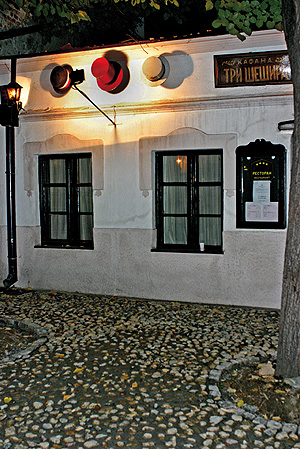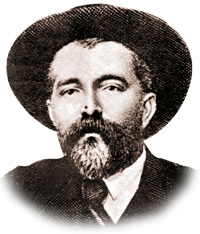My Serbia
ANCIENT QUARTERS OF SEBRIAN TOWNS: SKADARLIJA
The Bohemian History of Belgrade
”They sat here until dawn, the lived here, they created, they made jokes and they cried… such great people as Bora Stanković, Jovan Jovanović Zmaj, Janko Veselinović, Milovan Glišić, Simo Matavulj, Radoje Domanović, Vojislav Ilić, Ivo Ćipiko, Veljko Petrović, Stanislav Vinaver, Branislav Nušić, Stevan Sremac… This is where Đura Jakšić wrote ‘Fight, My Brothers’ (‘Padajte, braćo’) and 'Stanoje Glavaš', where Rade Drainac collected money for 'Hipnos' (a magazine) and until morning he would lose it all, where Ilija Stanojević, Vela Nigrinova, Dobrica Milutinović, Žanka Stokić worked on their theatre parts, where Tin Ujević, Gustav Krklec, Sibe Miličić all became true Belgrade men…”
By: Bane Velimirović
 ”My name is Skadarlija, or Skadarska Street, as you like it. I am no boulevard, avenue, or highway, but a simple curved little street in the centre of Belgrade. And that would be all worth saying about me if there were not for my bohemian history, my old roofs, my cracked chairs and hidden holes…” ”My name is Skadarlija, or Skadarska Street, as you like it. I am no boulevard, avenue, or highway, but a simple curved little street in the centre of Belgrade. And that would be all worth saying about me if there were not for my bohemian history, my old roofs, my cracked chairs and hidden holes…”
This is how the famous Zuko Džumhur, a caricaturist and a writer, a bohemian and a living and walking chronicle of Belgrade, wrote about Skadarlija. In the first half of the 19th century, Skadarlija was out of the town walls, right besides the ramparts, which went down to Dorćol, the gypsy area, and the gathering place of the poor, with a stream in the centre. How did it ever become for Belgrade what Montmartre is for Paris or Grienzig for Vienna?
When the Turkish army left Belgrade on April 24th 1867, a new history of the capital began. The town centre started getting bigger, the ramparts were torn down, and the modernization began, as well as the introduction of European fashion and manners. Back in 1854, this street was marked on the map for the first time, and in 1867, it became part of the urbanistic plan. The gypsy quarter was then dispersed, a real street was covered in cobblestones, and many houses were built in it. Then came ”small officers, apprentices, artisans, kalfe and coffee shop owners”. Five years later, in 1872, the street got its present name (only once, under Austrian occupation, the street was called Ružina Street).
When the National Theatre was built and when the first play was seen in it, in 1896, about a year after the beginning of the building, near the ancient Stambol Gate, cheap rooms and actors, writers, and poets took apartments in this street. ”Here come the poor again!”, café owners screamed in Skadarska Street. Some time after that, we had a big brewery, a hat factory, several grocery stores, and craft shops… In the beginning of the 20th century, Belgrade had around 60 thousand citizens and more than 300 kafanas. About ten of them were in and around Skadarlija.
ON THE TABLE AND UNDERNEATH
 However, Skadarlija became a true bohemian centre right after the famous kafana ”Dardaneli” was torn down in 1901, on the Theatre square, where the National Museum is today. Very soon, the guests of ”Dardaneli”, the famous people of Belgrade poetry and art, started going down the narrow streets under the National Theatre, to kafanas in Skadarlija, and this street and the quarter around it became the centre of ”domestic mythology” of Belgrade. ”Without this street we could have never written the history of South Slavic literature”, said Matoš, who was a frequent guest. However, Skadarlija became a true bohemian centre right after the famous kafana ”Dardaneli” was torn down in 1901, on the Theatre square, where the National Museum is today. Very soon, the guests of ”Dardaneli”, the famous people of Belgrade poetry and art, started going down the narrow streets under the National Theatre, to kafanas in Skadarlija, and this street and the quarter around it became the centre of ”domestic mythology” of Belgrade. ”Without this street we could have never written the history of South Slavic literature”, said Matoš, who was a frequent guest.
Chroniclers say: ”They sat here until dawn, the lived here, they created, they made jokes and they cried… such great people as Bora Stanković, Jovan Jovanović Zmaj, Janko Veselinović, Milovan Glišić, Simo Matavulj, Radoje Domanović, Vojislav Ilić, Ivo Ćipiko, Veljko Petrović, Stanislav Vinaver, Branislav Nušić, Stevan Sremac… This is where Đura Jakšić wrote ‘Fight, My Brothers’ (‘Padajte, braćo’) and 'Stanoje Glavaš', where Rade Drainac collected money for 'Hipnos' (a magazine) and until morning he would lose it all, where Ilija Stanojević, Vela Nigrinova, Dobrica Milutinović, Žanka Stokić worked on their theatre parts, where Tin Ujević, Gustav Krklec, Sibe Miličić all became true Belgrade men…We should also mention Ivan Meštrović, Pjer Križanić and many more!”
Every one of them had his own kafana, and all kafanas had all the guests. The famous ”Bandist” was visited by the youngest and the noisiest; ”Bums” was famous for a cook ”the best one in Belgrade, and out of Belgrade”; in the beginning of the street, in ”Vuk Karadžić”, they served only brandy, on the table, but underneath it, as well. Đura Jakšić, Milorad Gavrilović and Dimitrije Ginić lived in Skadarlija. Whenever they came to Belgrade, they visited Skadarlija: Ivo Vojinović and Aleksa Šantić, and, of course, Svetozar Ćorović. In 1904, on the 100th anniversary of the First Serbian Uprising, Nadežda Petrović organized the First Yugoslav Exhibition in Belgrade, and she took her guests to Skadarlija every evening.
A SHORT LIST OF LOVE STORIES
 Beograd, Skadarlija, nocni zivot copy.jpg) Many foreign great men fell in love with Skadarlija. It was noted that Professor Alfred Janssen (Ph.D.), a Swedish writer, a Slavist, and the Secretary of the Nobel Institute, the translator of Njegoš, Mažuranić, Gundulić (of which he wrote a whole study), listened to the gusle playing of Janko Veselinović in kafana ”Tri šešira”, along with Sremac and čiča-Ilija. ”Two towns will remain in my heart forever”, he wrote. ”Dubrovnik and Belgrade. The first one charmed me with its sea and its vicinities, and the other with its people.” Many foreign great men fell in love with Skadarlija. It was noted that Professor Alfred Janssen (Ph.D.), a Swedish writer, a Slavist, and the Secretary of the Nobel Institute, the translator of Njegoš, Mažuranić, Gundulić (of which he wrote a whole study), listened to the gusle playing of Janko Veselinović in kafana ”Tri šešira”, along with Sremac and čiča-Ilija. ”Two towns will remain in my heart forever”, he wrote. ”Dubrovnik and Belgrade. The first one charmed me with its sea and its vicinities, and the other with its people.”
To all these charmed strangers, we should add the German historian and philosopher Hermann Wendel, the Russian writer Ivan Bunin, who were artists as great as Submatov, Novelli, Salvini, Matkovsky, Braginsky, Handke…
 However, Belgrade could have easily lost Skadarlija after World War II, and on its place, big grey buildings could have been built, which are still making the capital so ugly. The architect Uglješa Bogunović was its saviour, with his text in Politika, in 1957. He was seriously engaged in the matter that Skadarlija should be saved, turned into a pedestrian zone, in a ”living museum”, and to remain the Montmartre of Belgrade. So, Skadarlija was renovated in 1968. Nine years later, on October 22nd 1977, on the initiative of the town of Paris, Skadarlija officially became the ”counterpart” of Montmartre. However, Belgrade could have easily lost Skadarlija after World War II, and on its place, big grey buildings could have been built, which are still making the capital so ugly. The architect Uglješa Bogunović was its saviour, with his text in Politika, in 1957. He was seriously engaged in the matter that Skadarlija should be saved, turned into a pedestrian zone, in a ”living museum”, and to remain the Montmartre of Belgrade. So, Skadarlija was renovated in 1968. Nine years later, on October 22nd 1977, on the initiative of the town of Paris, Skadarlija officially became the ”counterpart” of Montmartre.
Until the present day, Skadarlija remained one of the most interesting tourist attractions of Belgrade. It has its Codex, its symbols are the cane, the carnation and the hat, it has its flag which is raised ”on the beginning of the season” (this quarter is always popular, never mind the season). However, it seems that the time has come for better and more creative people to deal with the renaissance and the spirit of Skadarlija.
***
Culture
Old quarters of Serbian towns were better preserved by their culture and stories, than by their urbanists and mayors. Skadarlija is a great example. In the places where histories of old quarters were a part of the cultural history, like in Skadarlija, it was much more difficult to try to ruin those places, and the role of these town quarters was much more serious. It is true that the history of Yugoslav and Serbian literature would not be so rich and interesting without Skadarlija. Probably, Skadarlija would not even exist today. Someone would have already made a plan to destroy it, turning it into a shopping mall or something else of the kind.
|
